Android 16 में, डेवलपर के लिए बेहतरीन नई सुविधाएं और एपीआई जोड़े गए हैं. इन सुविधाओं के बारे में खास जानकारी देने के लिए, यहां दिए गए सेक्शन बनाए गए हैं. इनसे आपको मिलते-जुलते एपीआई का इस्तेमाल शुरू करने में मदद मिलेगी.
नए, बदले गए, और हटाए गए एपीआई की पूरी सूची के लिए, एपीआई के बीच अंतर की रिपोर्ट पढ़ें. नए एपीआई के बारे में ज़्यादा जानने के लिए, Android एपीआई का रेफ़रंस देखें — नए एपीआई को हाइलाइट किया गया है, ताकि उन्हें आसानी से देखा जा सके.आपको उन जगहों की भी समीक्षा करनी चाहिए जहां प्लैटफ़ॉर्म में हुए बदलावों का आपके ऐप्लिकेशन पर असर पड़ सकता है. ज़्यादा जानकारी के लिए, ये पेज देखें:
- Android 16 को टारगेट करने पर, ऐप्लिकेशन के काम करने के तरीके में होने वाले बदलाव
- ऐसे बदलाव जो
targetSdkVersionके बावजूद, सभी ऐप्लिकेशन पर असर डालते हैं.
मुख्य फ़ंक्शन
Android में नए एपीआई शामिल हैं, जो Android सिस्टम की मुख्य सुविधाओं को बेहतर बनाते हैं.
साल 2025 में Android के दो एपीआई रिलीज़ किए जाएंगे
- यह झलक, Android के अगले मेजर वर्शन के लिए है. इसे 2025 की दूसरी तिमाही में लॉन्च किया जाएगा. यह रिलीज़, एपीआई की पिछली सभी रिलीज़ से मिलती-जुलती है. इसमें, व्यवहार में ऐसे बदलाव किए जा सकते हैं जो अक्सर targetSdkVersion से जुड़े होते हैं.
- हम मेजर रिलीज़ को एक तिमाही पहले रिलीज़ करने जा रहे हैं. पिछले सालों में, यह रिलीज़ तीसरी तिमाही में होती थी, लेकिन अब इसे दूसरी तिमाही में रिलीज़ किया जाएगा. ऐसा इसलिए किया जा रहा है, ताकि हमारे पूरे नेटवर्क में डिवाइस लॉन्च करने के शेड्यूल के साथ बेहतर तरीके से अलाइन किया जा सके. इससे ज़्यादा डिवाइसों पर Android का मेजर वर्शन जल्दी रिलीज़ किया जा सकेगा. साल की दूसरी तिमाही में, Android के नए वर्शन की रिलीज़ होने वाली है. इसलिए, आपको सालाना होने वाली, ऐप्लिकेशन के काम करने की जांच को पिछले सालों की तुलना में कुछ महीने पहले करना होगा. इससे यह पक्का किया जा सकेगा कि आपके ऐप्लिकेशन, नए वर्शन के साथ काम कर रहे हैं.
- हम साल 2025 की चौथी तिमाही में एक और रिलीज़ करने वाले हैं. इसमें नए डेवलपर एपीआई भी शामिल होंगे. साल 2025 में, दूसरी तिमाही में होने वाली मेजर रिलीज़ में ही, व्यवहार से जुड़े ऐसे बदलाव शामिल होंगे जिनका ऐप्लिकेशन पर असर पड़ सकता है.
चौथी तिमाही की मामूली रिलीज़ में, डेवलपर के लिए नए एपीआई के साथ-साथ, सुविधाओं के अपडेट, ऑप्टिमाइज़ेशन, और गड़बड़ियों को ठीक करने की सुविधाएं भी शामिल होंगी. हालांकि, इसमें ऐप्लिकेशन के काम करने के तरीके में कोई बदलाव नहीं किया जाएगा.

हम हर तीन महीने में Android वर्शन रिलीज़ करते रहेंगे. एपीआई रिलीज़ के बीच में, Q1 और Q3 के अपडेट से क्वालिटी को बेहतर बनाने में मदद मिलेगी. हम डिवाइस पार्टनर के साथ मिलकर, Q2 रिलीज़ को ज़्यादा से ज़्यादा डिवाइसों पर उपलब्ध कराने के लिए काम कर रहे हैं.
मुख्य और मामूली रिलीज़ के साथ नए एपीआई का इस्तेमाल करना
एपीआई लेवल की जांच करके, कोड ब्लॉक को सुरक्षित रखने के लिए, अब SDK_INT कॉन्स्टेंट के साथ VERSION_CODES का इस्तेमाल किया जाता है. यह सुविधा, Android के मुख्य वर्शन के लिए काम करती रहेगी.
if (SDK_INT >= VERSION_CODES.BAKLAVA) {
// Use APIs introduced in Android 16
}
नए SDK_INT_FULL
कंसटेंट का इस्तेमाल, एपीआई की जांच के लिए किया जा सकता है. यह जांच, नए VERSION_CODES_FULL
एन्यूमरेशन की मदद से, मेजर और माइनर, दोनों वर्शन के लिए की जा सकती है.
if (SDK_INT_FULL >= VERSION_CODES_FULL.[MAJOR or MINOR RELEASE]) {
// Use APIs introduced in a major or minor release
}
SDK टूल का सिर्फ़ मामूली वर्शन पाने के लिए, Build.getMinorSdkVersion() के तरीके का भी इस्तेमाल किया जा सकता है.
val minorSdkVersion = Build.getMinorSdkVersion(VERSION_CODES_FULL.BAKLAVA)
इन एपीआई को अभी तक फ़ाइनल नहीं किया गया है और इनमें बदलाव हो सकते हैं. इसलिए, अगर आपको कोई समस्या है, तो कृपया हमें सुझाव/राय दें या शिकायत करें.
उपयोगकर्ता अनुभव और सिस्टम यूज़र इंटरफ़ेस (यूआई)
Android 16, ऐप्लिकेशन डेवलपर और उपयोगकर्ताओं को ज़्यादा कंट्रोल और सुविधाएं देता है. इससे वे अपनी ज़रूरतों के हिसाब से अपने डिवाइस को कॉन्फ़िगर कर सकते हैं.
प्रोग्रेस से जुड़ी सूचनाएं
Android 16 में, प्रोग्रेस पर आधारित सूचनाएं देने की सुविधा जोड़ी गई है. इससे उपयोगकर्ताओं को, शुरू से लेकर आखिर तक की प्रोसेस को आसानी से ट्रैक करने में मदद मिलती है.
Notification.ProgressStyle, सूचनाओं का एक नया स्टाइल है. इसकी मदद से, प्रोग्रेस के बारे में सूचनाएं बनाई जा सकती हैं. इस्तेमाल के मुख्य उदाहरणों में, राइडशेयर, डिलीवरी, और नेविगेशन शामिल हैं. Notification.ProgressStyle
क्लास में, पॉइंट और सेगमेंट का इस्तेमाल करके, उपयोगकर्ता के सफ़र में स्टेटस और माइलस्टोन दिखाए जा सकते हैं.
ज़्यादा जानने के लिए, प्रगति से जुड़ी सूचनाएं दस्तावेज़ पेज देखें.
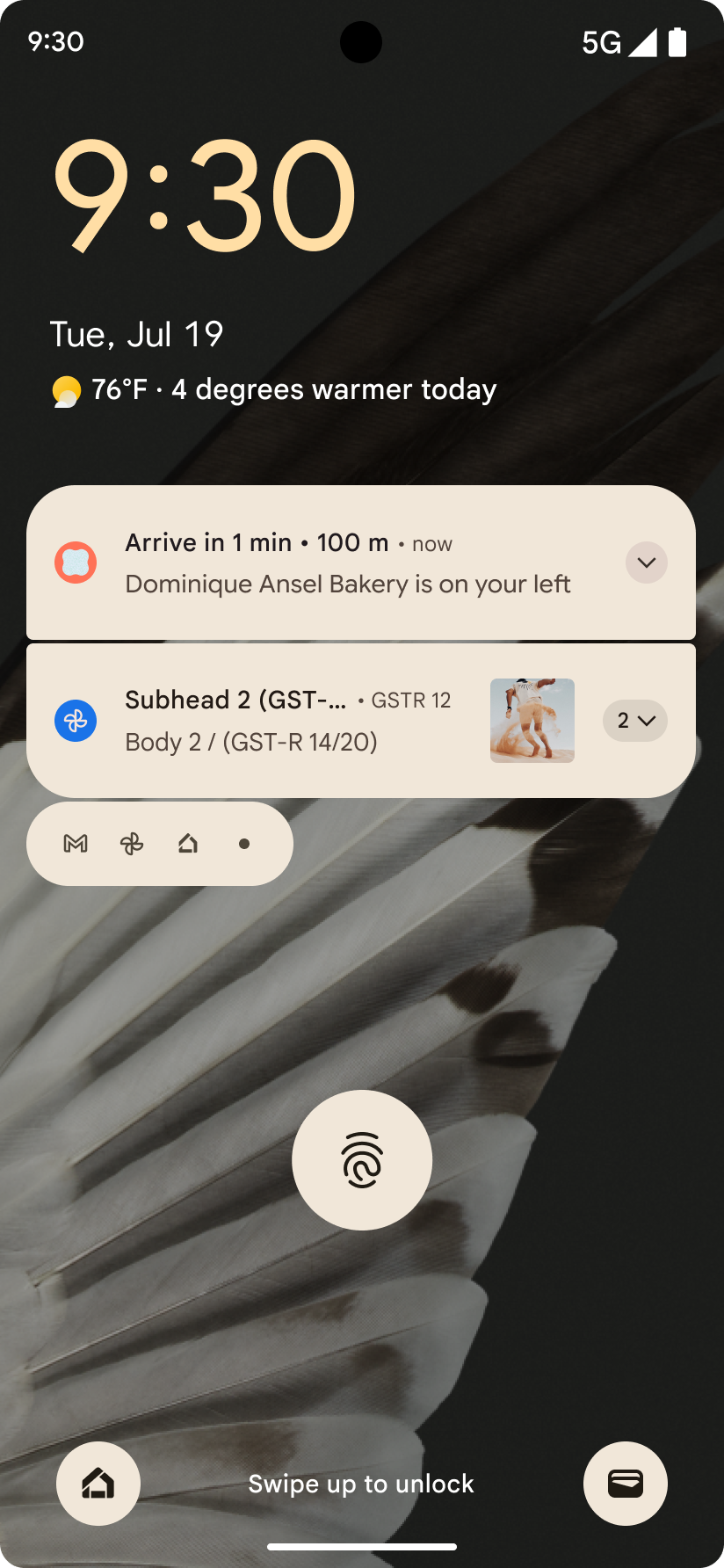
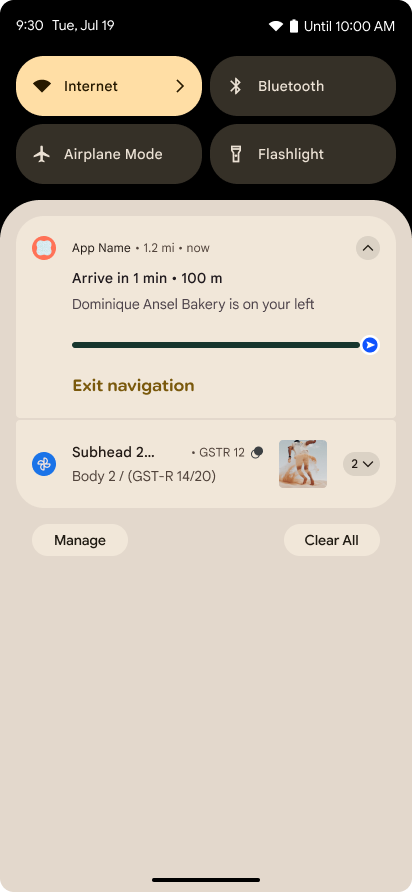
'पीछे जाने पर झलक दिखाने वाला हाथ का जेस्चर' सुविधा से जुड़े अपडेट
Android 16 में नए एपीआई जोड़े गए हैं. इनकी मदद से, जेस्चर नेविगेशन में प्रिडिक्टिव बैक सिस्टम ऐनिमेशन चालू किए जा सकते हैं. जैसे, होम पेज पर वापस जाने के लिए ऐनिमेशन. onBackInvokedCallback को नए PRIORITY_SYSTEM_NAVIGATION_OBSERVER के साथ रजिस्टर करने पर, आपके ऐप्लिकेशन को सामान्य onBackInvoked कॉल तब मिलता है, जब सिस्टम बैक नेविगेशन को मैनेज करता है. इससे, बैक नेविगेशन के सामान्य फ़्लो पर कोई असर नहीं पड़ता.
Android 16 में,
finishAndRemoveTaskCallback() और
moveTaskToBackCallback भी जोड़े गए हैं. OnBackInvokedDispatcher के साथ इन कॉलबैक को रजिस्टर करके, सिस्टम कुछ खास व्यवहार को ट्रिगर कर सकता है. साथ ही, बैक जेस्चर का इस्तेमाल करने पर, उससे जुड़े ऐनिमेशन को पहले से चला सकता है.
बेहतर हैप्टिक
Android ने शुरुआत से ही, हैप्टिक ऐक्चुएटर को कंट्रोल करने की सुविधा दी है.
Android 11 में, ज़्यादा जटिल हैप्टिक इफ़ेक्ट के लिए सहायता जोड़ी गई है. ये इफ़ेक्ट, डिवाइस के लिए तय किए गए सेमैंटिक प्राइमिटिव के VibrationEffect.Compositions की मदद से, ज़्यादा बेहतर ऐक्चुएटर के साथ काम कर सकते हैं.
Android 16 में हैप्टिक एपीआई जोड़े गए हैं. इनकी मदद से, ऐप्लिकेशन किसी हैप्टिक इफ़ेक्ट के ऐम्प्ल्यट्यूड और फ़्रीक्वेंसी कर्व तय कर सकते हैं. साथ ही, डिवाइस की क्षमताओं के बीच के अंतर को भी हटा सकते हैं.
डेवलपर की प्रोडक्टिविटी और टूल
आपकी प्रॉडक्टिविटी बढ़ाने के लिए, हम Android Studio, Jetpack Compose, और Android Jetpack लाइब्रेरी जैसे टूल पर काम करते हैं. हालांकि, हम हमेशा प्लैटफ़ॉर्म में ऐसे तरीके ढूंढते रहते हैं जिनसे आपको अपने लक्ष्य को हासिल करने में मदद मिल सके.
लाइव वॉलपेपर के लिए कॉन्टेंट मैनेज करना
In Android 16, the live wallpaper framework is gaining a new content API to
address the challenges of dynamic, user-driven wallpapers. Currently, live
wallpapers incorporating user-provided content require complex, service-specific
implementations. Android 16 introduces
WallpaperDescription and
WallpaperInstance. WallpaperDescription lets you
identify distinct instances of a live wallpaper from the same service. For
example, a wallpaper that has instances on both the home screen and on the lock
screen may have unique content in both places. The wallpaper picker and
WallpaperManager use this metadata to better present
wallpapers to users, streamlining the process for you to create diverse and
personalized live wallpaper experiences.
परफ़ॉर्मेंस और बैटरी
Android 16 में ऐसे एपीआई शामिल किए गए हैं जिनकी मदद से, आपके ऐप्लिकेशन के बारे में अहम जानकारी इकट्ठा की जा सकती है.
सिस्टम से ट्रिगर की गई प्रोफ़ाइलिंग
ProfilingManager को Android 15 में जोड़ा गया था. इससे ऐप्लिकेशन, फ़ील्ड में मौजूद सार्वजनिक डिवाइसों पर Perfetto का इस्तेमाल करके, प्रोफ़ाइलिंग डेटा इकट्ठा करने का अनुरोध कर सकते हैं.
हालांकि, यह प्रोफ़ाइलिंग ऐप्लिकेशन से शुरू की जानी चाहिए. इसलिए, ऐप्लिकेशन के लिए स्टार्टअप या ANR जैसे अहम फ़्लो को कैप्चर करना मुश्किल या असंभव होगा.
इसकी मदद करने के लिए, Android 16 में ProfilingManager के लिए, सिस्टम से ट्रिगर की जाने वाली प्रोफ़ाइलिंग की सुविधा जोड़ी गई है. ऐप्लिकेशन, कुछ ट्रिगर के लिए ट्रेस पाने में दिलचस्पी रजिस्टर कर सकते हैं. जैसे, कोल्ड स्टार्ट reportFullyDrawn या ANR. इसके बाद, सिस्टम ऐप्लिकेशन की ओर से ट्रेस शुरू और बंद करता है. ट्रैक पूरा होने के बाद, नतीजे ऐप्लिकेशन की डेटा डायरेक्ट्री में डिलीवर किए जाते हैं.
ApplicationStartInfo में कॉम्पोनेंट शुरू करना
ApplicationStartInfo was added in Android
15, allowing an app to see reasons
for process start, start type, start times, throttling, and other useful
diagnostic data. Android 16 adds
getStartComponent()
to distinguish what component type triggered the start, which can be helpful for
optimizing the startup flow of your app.
नौकरी के बारे में बेहतर तरीके से जानकारी पाना
JobScheduler#getPendingJobReason() एपीआई, किसी जॉब के लंबित होने की वजह बताता है. हालांकि, किसी जॉब के पूरा न होने की कई वजहें हो सकती हैं.
हम Android 16 में एक नया एपीआई JobScheduler#getPendingJobReasons(int jobId) पेश कर रहे हैं. इससे, किसी जॉब के लंबे समय से पेंडिंग होने की कई वजहें पता चलती हैं. ये वजहें, डेवलपर की ओर से सेट की गई साफ़ तौर पर बताई गई पाबंदियों और सिस्टम की ओर से सेट की गई छिपी हुई पाबंदियों, दोनों की वजह से होती हैं.
हम JobScheduler#getPendingJobReasonsHistory(int jobId) को भी पेश कर रहे हैं. इससे, पाबंदी में हुए सबसे हाल के बदलावों की सूची दिखती है.
हमारा सुझाव है कि एपीआई का इस्तेमाल करके, यह पता लगाएं कि आपकी जॉब क्यों नहीं चल रही हैं. ऐसा खास तौर पर तब करें, जब आपको कुछ टास्क के पूरा होने की दर में कमी दिख रही हो या किसी जॉब के पूरा होने में लगने वाले समय से जुड़ी गड़बड़ियां दिख रही हों. उदाहरण के लिए, बैकग्राउंड में विजेट अपडेट नहीं हो पाए या ऐप्लिकेशन शुरू होने से पहले, डेटा को पहले से लोड करने की सुविधा को कॉल नहीं किया जा सका.
इससे आपको यह समझने में भी मदद मिल सकती है कि कुछ जॉब, सिस्टम की तय की गई पाबंदियों की वजह से पूरी नहीं हो रहे हैं या साफ़ तौर पर सेट की गई पाबंदियों की वजह से.
अडैप्टिव रीफ़्रेश रेट
Android 15 में, अडैप्टिव रिफ़्रेश रेट (एआरआर) की सुविधा जोड़ी गई है. इसकी मदद से, डिसप्ले रिफ़्रेश रेट को डिवाइस के हिसाब से अडजस्ट किया जा सकता है. इसके लिए, अलग-अलग VSync चरण का इस्तेमाल करके, कॉन्टेंट के फ़्रेम रेट के हिसाब से डिसप्ले रिफ़्रेश रेट को अडजस्ट किया जाता है. इससे बिजली की खपत कम होती है. साथ ही, मोड स्विच करने की ज़रूरत भी नहीं पड़ती.
Android 16 में hasArrSupport() और
getSuggestedFrameRate(int) को शामिल किया गया है. साथ ही, getSupportedRefreshRates() को वापस लाया गया है, ताकि आपके ऐप्लिकेशन आसानी से ARR का फ़ायदा ले सकें. RecyclerView
1.4, फ़्लिंग या स्मूद स्क्रोल से सेटल होने पर, अंदरूनी तौर पर ARR के साथ काम करता है. हम ज़्यादा Jetpack लाइब्रेरी में ARR की सुविधा जोड़ने के लिए काम कर रहे हैं. फ़्रेम रेट के बारे में इस लेख में, ऐसे कई एपीआई के बारे में बताया गया है जिनका इस्तेमाल करके फ़्रेम रेट सेट किया जा सकता है. इससे आपका ऐप्लिकेशन सीधे तौर पर ARR का इस्तेमाल कर सकता है.
ADPF में Headroom API
The SystemHealthManager introduces the
getCpuHeadroom and
getGpuHeadroom APIs, designed to provide games and
resource-intensive apps with estimates of available CPU and GPU resources. These
methods offer a way for you to gauge how your app or game can best improve
system health, particularly when used in conjunction with other Android Dynamic
Performance Framework (ADPF) APIs that detect thermal
throttling.
By using CpuHeadroomParams and
GpuHeadroomParams on supported devices, you can
customize the time window used to compute the headroom and select between
average or minimum resource availability. This can help you reduce your CPU or
GPU resource usage accordingly, leading to better user experiences and improved
battery life.
सुलभता
Android 16 में, सुलभता से जुड़े नए एपीआई और सुविधाएं जोड़ी गई हैं. इनकी मदद से, हर उपयोगकर्ता के लिए अपना ऐप्लिकेशन उपलब्ध कराया जा सकता है.
सुलभता से जुड़े बेहतर एपीआई
Android 16 adds additional APIs to enhance UI semantics that help improve consistency for users that rely on accessibility services, such as TalkBack.
Outline text for maximum text contrast
Users with low vision often have reduced contrast sensitivity, making it challenging to distinguish objects from their backgrounds. To help these users, Android 16 introduces outline text, replacing high contrast text, which draws a larger contrasting area around text to greatly improve legibility.
Android 16 contains new AccessibilityManager APIs to let
your apps check or register a listener to
see if this mode is enabled. This is primarily for UI Toolkits like Compose to
offer a similar visual experience. If you maintain a UI Toolkit library or your
app performs custom text rendering that bypasses the
android.text.Layout class then you can use this to know
when outline text is enabled.
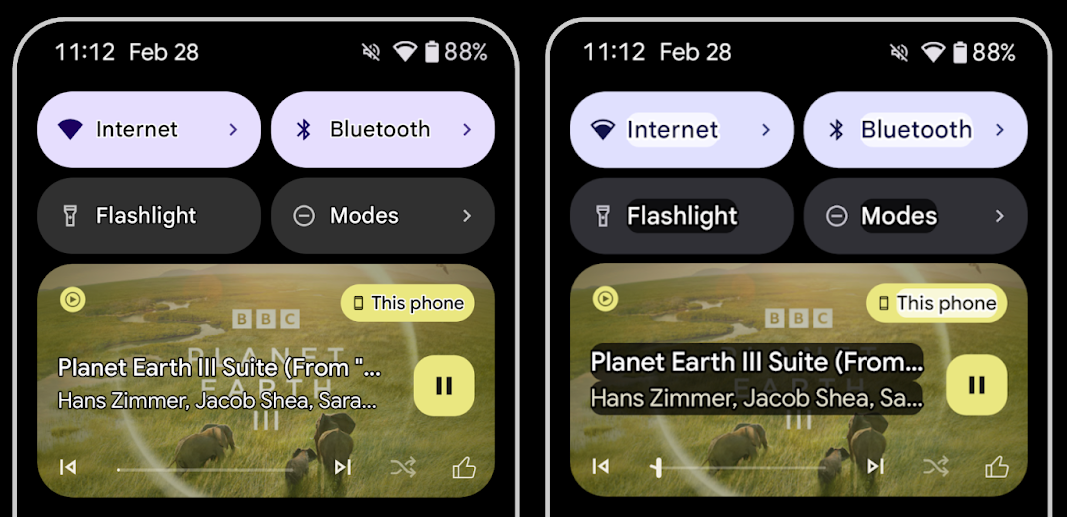
Duration added to TtsSpan
Android 16 extends TtsSpan with a TYPE_DURATION,
consisting of ARG_HOURS, ARG_MINUTES,
and ARG_SECONDS. This lets you directly annotate time
duration, ensuring accurate and consistent text-to-speech output with services
like TalkBack.
Support elements with multiple labels
Android currently allows UI elements to derive their accessibility label from
another, and now offers the ability for multiple labels to be associated, a
common scenario in web content. By introducing a list-based API within
AccessibilityNodeInfo, Android can directly support these
multi-label relationships. As part of this change, we've deprecated
AccessibilityNodeInfo#setLabeledBy and
#getLabeledBy in favor of
#addLabeledBy, #removeLabeledBy, and
#getLabeledByList.
Improved support for expandable elements
Android 16 adds accessibility APIs that allow you to convey the expanded or
collapsed state of interactive elements, such as menus and expandable lists. By
setting the expanded state using setExpandedState and
dispatching TYPE_WINDOW_CONTENT_CHANGED AccessibilityEvents
with a CONTENT_CHANGE_TYPE_EXPANDED content change type,
you can ensure that screen readers like TalkBack announce
state changes, providing a more intuitive and inclusive user experience.
Indeterminate ProgressBars
Android 16 adds RANGE_TYPE_INDETERMINATE, giving a way for
you to expose RangeInfo for both determinate and
indeterminate ProgressBar widgets, allowing services like
TalkBack to more consistently provide feedback for progress
indicators.
Tri-state CheckBox
The new AccessibilityNodeInfo
getChecked and setChecked(int)
methods in Android 16 now support a "partially checked" state in addition to
"checked" and "unchecked." This replaces the deprecated boolean
isChecked and setChecked(boolean).
Supplemental descriptions
When an accessibility service describes a ViewGroup, it
combines content labels from its child views. If you provide a
contentDescription for the ViewGroup, accessibility services assume you are
also overriding the description of non-focusable child views. This can be
problematic if you want to label things like a drop-down (for example, "Font
Family") while preserving the current selection for accessibility (for example,
"Roboto"). Android 16 adds setSupplementalDescription so
you can provide text that provides information about a ViewGroup without
overriding information from its children.
Required form fields
Android 16 adds setFieldRequired to
AccessibilityNodeInfo so apps can tell an accessibility
service that input to a form field is required. This is an important scenario
for users filling out many types of forms, even things as simple as a required
terms and conditions checkbox, helping users to consistently identify and
quickly navigate between required fields.
LEA कान की मशीनों के साथ वॉइस कॉल के लिए, फ़ोन को माइक्रोफ़ोन इनपुट के तौर पर इस्तेमाल करना
Android 16 में, LE Audio की सुविधा वाले कान की मशीन के उपयोगकर्ताओं के लिए, वॉइस कॉल के लिए कान की मशीन में पहले से मौजूद माइक्रोफ़ोन और फ़ोन के माइक्रोफ़ोन के बीच स्विच करने की सुविधा जोड़ी गई है. यह सुविधा, शोर वाले माहौल या ऐसी अन्य स्थितियों में मददगार हो सकती है जहां कान की मशीन के माइक्रोफ़ोन ठीक से काम न कर पाएं.
LEA कान की मशीनों के लिए, आस-पास की आवाज़ के हिसाब से वॉल्यूम कंट्रोल करने की सुविधा
Android 16 adds the capability for users of LE Audio hearing aids to adjust the volume of ambient sound that is picked up by the hearing aid's microphones. This can be helpful in situations where background noise is too loud or too quiet.
कैमरा
Android 16 में, प्रोफ़ेशनल कैमरे इस्तेमाल करने वाले लोगों के लिए बेहतर सुविधाएं जोड़ी गई हैं. इनमें, कलर टेंपरेचर और टिनट में सटीक बदलाव करने के साथ-साथ, हाइब्रिड ऑटो एक्सपोज़र की सुविधा भी शामिल है. नाइट मोड के नए इंडिकेटर की मदद से, आपके ऐप्लिकेशन को यह पता चलता है कि नाइट मोड वाले कैमरे सेशन पर कब स्विच करना है और कब उससे वापस आना है. Intent के नए ऐक्शन की मदद से, मोशन फ़ोटो आसानी से कैप्चर की जा सकती हैं. साथ ही, हम HEIC एन्कोडिंग और ISO 21496-1 ड्राफ़्ट स्टैंडर्ड के नए पैरामीटर की मदद से, अल्ट्रा एचडीआर इमेज को बेहतर बना रहे हैं.
हाइब्रिड ऑटो एक्सपोज़र
Android 16 adds new hybrid auto-exposure modes to Camera2, allowing you to manually control specific aspects of exposure while letting the auto-exposure (AE) algorithm handle the rest. You can control ISO + AE, and exposure time + AE, providing greater flexibility compared to the current approach where you either have full manual control or rely entirely on auto-exposure.
fun setISOPriority() {
// ... (Your existing code before the snippet) ...
val availablePriorityModes = mStaticInfo.characteristics.get(
CameraCharacteristics.CONTROL_AE_AVAILABLE_PRIORITY_MODES
)
// ... (Your existing code between the snippets) ...
// Turn on AE mode to set priority mode
reqBuilder.set(
CaptureRequest.CONTROL_AE_MODE,
CameraMetadata.CONTROL_AE_MODE_ON
)
reqBuilder.set(
CaptureRequest.CONTROL_AE_PRIORITY_MODE,
CameraMetadata.CONTROL_AE_PRIORITY_MODE_SENSOR_SENSITIVITY_PRIORITY
)
reqBuilder.set(
CaptureRequest.SENSOR_SENSITIVITY,
TEST_SENSITIVITY_VALUE
)
val request: CaptureRequest = reqBuilder.build()
// ... (Your existing code after the snippet) ...
}
कलर टेंपरेचर और टिनट में सटीक बदलाव करना
Android 16 adds camera support for fine color temperature and tint adjustments
to better support professional video recording applications. In previous Android
versions, you could control white balance settings through
CONTROL_AWB_MODE, which contains options limited to a
preset list, such as Incandescent,
Cloudy, and Twilight. The
COLOR_CORRECTION_MODE_CCT enables the use of
COLOR_CORRECTION_COLOR_TEMPERATURE and
COLOR_CORRECTION_COLOR_TINT for precise adjustments of
white balance based on the correlated color temperature.
fun setCCT() {
// ... (Your existing code before this point) ...
val colorTemperatureRange: Range<Int> =
mStaticInfo.characteristics[CameraCharacteristics.COLOR_CORRECTION_COLOR_TEMPERATURE_RANGE]
// Set to manual mode to enable CCT mode
reqBuilder[CaptureRequest.CONTROL_AWB_MODE] = CameraMetadata.CONTROL_AWB_MODE_OFF
reqBuilder[CaptureRequest.COLOR_CORRECTION_MODE] = CameraMetadata.COLOR_CORRECTION_MODE_CCT
reqBuilder[CaptureRequest.COLOR_CORRECTION_COLOR_TEMPERATURE] = 5000
reqBuilder[CaptureRequest.COLOR_CORRECTION_COLOR_TINT] = 30
val request: CaptureRequest = reqBuilder.build()
// ... (Your existing code after this point) ...
}
The following examples show how a photo would look after applying different color temperature and tint adjustments:
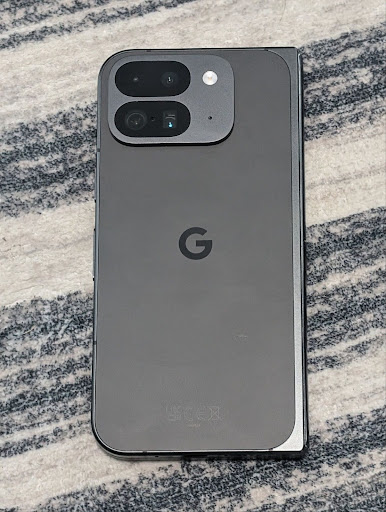
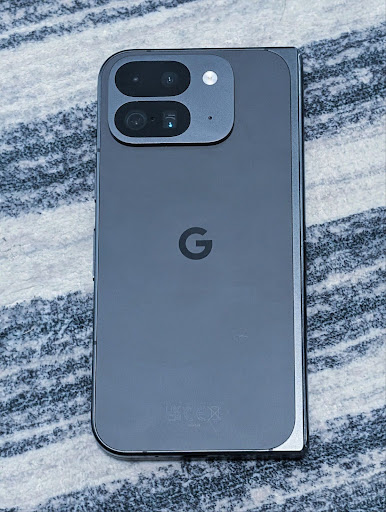

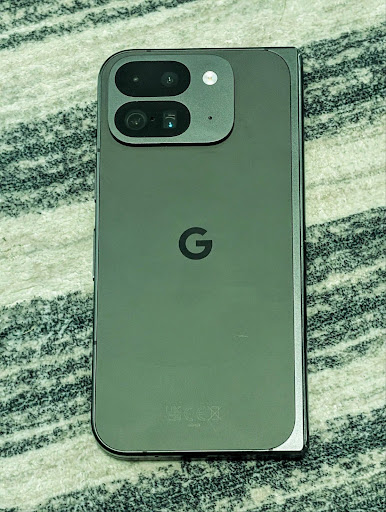
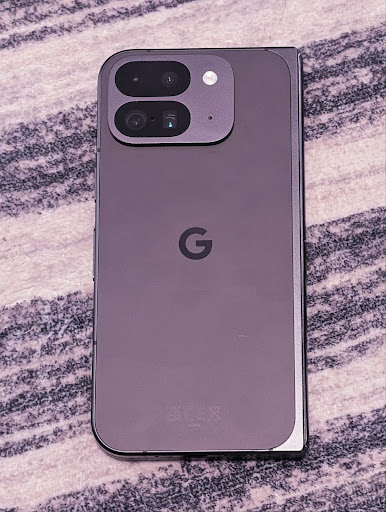
कैमरे के नाइट मोड में सीन की पहचान करने की सुविधा
To help your app know when to switch to and from a night mode camera session,
Android 16 adds EXTENSION_NIGHT_MODE_INDICATOR. If
supported, it's available in the CaptureResult within
Camera2.
This is the API we briefly mentioned as coming soon in the How Instagram enabled users to take stunning low light photos blog post. That post is a practical guide on how to implement night mode together with a case study that links higher-quality in-app night mode photos with an increase in the number of photos shared from the in-app camera.
मोशन फ़ोटो कैप्चर करने के लिए इंटेंट ऐक्शन
Android 16 में स्टैंडर्ड इंटेंट ऐक्शन —
ACTION_MOTION_PHOTO_CAPTURE और
ACTION_MOTION_PHOTO_CAPTURE_SECURE — जोड़े गए हैं. इनसे कैमरा ऐप्लिकेशन को मोशन फ़ोटो कैप्चर करने और उसे दिखाने का अनुरोध किया जाता है.
इमेज को कहां लिखा जाएगा, यह कंट्रोल करने के लिए आपको एक अतिरिक्त EXTRA_OUTPUT पास करना होगा या Intent.setClipData(ClipData) के ज़रिए Uri पास करना होगा. अगर आपने कोई ClipData सेट नहीं किया है, तो Context.startActivity(Intent) को कॉल करते समय वह आपके लिए वहां कॉपी हो जाएगा.
अल्ट्रा एचडीआर की मदद से इमेज को बेहतर बनाना
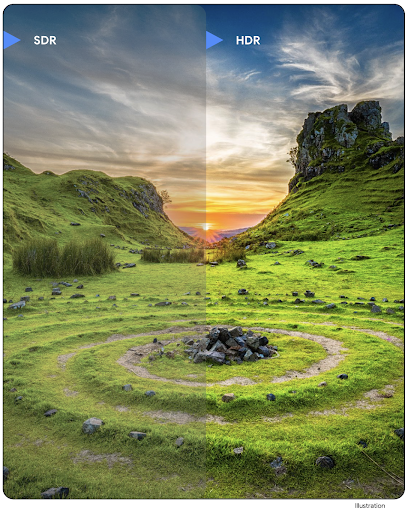
Android 16 continues our work to deliver dazzling image quality with UltraHDR
images. It adds support for UltraHDR images in the HEIC file
format. These images will get ImageFormat type
HEIC_ULTRAHDR and will contain an embedded gainmap similar
to the existing UltraHDR JPEG format. We're working on AVIF support for UltraHDR
as well, so stay tuned.
In addition, Android 16 implements additional parameters in UltraHDR from the ISO 21496-1 draft standard, including the ability to get and set the colorspace that gainmap math should be applied in, as well as support for HDR encoded base images with SDR gainmaps.
ग्राफ़िक्स
Android 16 में, ग्राफ़िक से जुड़े नए सुधार शामिल हैं. जैसे, AGSL की मदद से कस्टम ग्राफ़िक इफ़ेक्ट.
एजीएसएल की मदद से, पसंद के मुताबिक ग्राफ़िक इफ़ेक्ट
Android 16 में RuntimeColorFilter और
RuntimeXfermode जोड़े गए हैं. इनकी मदद से, थ्रेशोल्ड, सेपिया, और ह्यू सेचुरेशन जैसे जटिल इफ़ेक्ट बनाए जा सकते हैं. साथ ही, इन्हें ड्रॉ कॉल पर लागू किया जा सकता है. Android 13 के बाद से, AGSL का इस्तेमाल करके, Shader को बढ़ाने वाले कस्टम RuntimeShaders बनाए जा सकते हैं. नया एपीआई, AGSL की मदद से काम करने वाला RuntimeColorFilter जोड़ता है, जो ColorFilter को बढ़ाता है. साथ ही, इसमें Xfermode इफ़ेक्ट भी जोड़ा गया है, जिसकी मदद से सोर्स और डेस्टिनेशन पिक्सल के बीच, AGSL पर आधारित कस्टम कंपोजिटिंग और ब्लेंडिंग लागू की जा सकती है.
private val thresholdEffectString = """
uniform half threshold;
half4 main(half4 c) {
half luminosity = dot(c.rgb, half3(0.2126, 0.7152, 0.0722));
half bw = step(threshold, luminosity);
return bw.xxx1 * c.a;
}"""
fun setCustomColorFilter(paint: Paint) {
val filter = RuntimeColorFilter(thresholdEffectString)
filter.setFloatUniform(0.5);
paint.colorFilter = filter
}
कनेक्टिविटी
Android 16, प्लैटफ़ॉर्म को अपडेट करता है, ताकि आपके ऐप्लिकेशन को कम्यूनिकेशन और वायरलेस टेक्नोलॉजी से जुड़ी नई सुविधाओं का ऐक्सेस मिल सके.
बेहतर सुरक्षा के साथ रेंजिंग
Android 16 adds support for robust security features in Wi-Fi location on supported devices with Wi-Fi 6's 802.11az, allowing apps to combine the higher accuracy, greater scalability, and dynamic scheduling of the protocol with security enhancements including AES-256-based encryption and protection against MITM attacks. This allows it to be used more safely in proximity use cases, such as unlocking a laptop or a vehicle door. 802.11az is integrated with the Wi-Fi 6 standard, leveraging its infrastructure and capabilities for wider adoption and easier deployment.
सामान्य रेंजिंग एपीआई
Android 16 includes the new RangingManager, which provides
ways to determine the distance and angle on supported hardware between the local
device and a remote device. RangingManager supports the usage of a variety of
ranging technologies such as BLE channel sounding, BLE RSSI-based ranging, Ultra
Wideband, and Wi-Fi round trip time.
मीडिया
Android 16 में कई सुविधाएं शामिल हैं, जिनसे मीडिया का अनुभव बेहतर होता है.
फ़ोटो पिकर में किए गए सुधार
फ़ोटो पिकर की सुविधा, उपयोगकर्ताओं के लिए ऐप्लिकेशन में पहले से मौजूद है. इसकी मदद से, उपयोगकर्ता अपने डिवाइस की पूरी मीडिया लाइब्रेरी के बजाय, ऐप्लिकेशन को सिर्फ़ अपनी चुनी हुई फ़ोटो और वीडियो का ऐक्सेस दे सकते हैं. यह सुविधा सुरक्षित है. Google के सिस्टम अपडेट और Google Play services की मदद से, मॉड्यूलर सिस्टम कॉम्पोनेंट का इस्तेमाल करके, यह सुविधा Android 4.4 (एपीआई लेवल 19) तक के वर्शन पर काम करती है. इंटिग्रेशन के लिए, Android Jetpack लाइब्रेरी के साथ सिर्फ़ कुछ लाइनों का कोड ज़रूरी है.
Android 16 में, फ़ोटो पिकर में ये सुधार किए गए हैं:
- एम्बेड किया गया फ़ोटो पिकर: नए एपीआई, जिनकी मदद से ऐप्लिकेशन, फ़ोटो पिकर को अपने व्यू की हैरारकी में एम्बेड कर सकते हैं. इससे, यह ऐप्लिकेशन के एक बेहतर हिस्से की तरह महसूस होता है. साथ ही, प्रोसेस को अलग रखने की सुविधा का फ़ायदा भी मिलता है. इस सुविधा की मदद से, उपयोगकर्ता ऐप्लिकेशन को ज़्यादा अनुमतियां दिए बिना ही मीडिया चुन सकते हैं. अगर आपको एम्बेड किए गए फ़ोटो पिकर को इंटिग्रेट करना है, तो आपको Android के आने वाले समय में लॉन्च होने वाली Jetpack लाइब्रेरी का इस्तेमाल करना होगा. इससे, सभी प्लैटफ़ॉर्म के वर्शन के साथ काम करने की सुविधा बढ़ेगी और इंटिग्रेशन आसान हो जाएगा.
- फ़ोटो पिकर में क्लाउड सर्च: Android फ़ोटो पिकर के लिए, क्लाउड मीडिया प्रोवाइडर से खोजने की सुविधा देने वाले नए एपीआई. फ़ोटो चुनने वाले टूल में खोजने की सुविधा जल्द ही उपलब्ध होगी.
बेहतर प्रोफ़ेशनल वीडियो
Android 16 introduces support for the Advanced Professional Video (APV) codec which is designed to be used for professional level high quality video recording and post production.
The APV codec standard has the following features:
- Perceptually lossless video quality (close to raw video quality)
- Low complexity and high throughput intra-frame-only coding (without pixel domain prediction) to better support editing workflows
- Support for high bit-rate range up to a few Gbps for 2K, 4K and 8K resolution content, enabled by a lightweight entropy coding scheme
- Frame tiling for immersive content and for enabling parallel encoding and decoding
- Support for various chroma sampling formats and bit-depths
- Support for multiple decoding and re-encoding without severe visual quality degradation
- Support multi-view video and auxiliary video like depth, alpha, and preview
- Support for HDR10/10+ and user-defined metadata
A reference implementation of APV is provided through the OpenAPV project. Android 16 will implement support for the APV 422-10 Profile that provides YUV 422 color sampling along with 10-bit encoding and for target bitrates of up to 2Gbps.
निजता
Android 16 में कई सुविधाएं शामिल हैं. इनकी मदद से, ऐप्लिकेशन डेवलपर उपयोगकर्ता की निजता को सुरक्षित रख सकते हैं.
Health Connect से जुड़े अपडेट
डेवलपर के लिए उपलब्ध झलक में, Health Connect में ACTIVITY_INTENSITY डेटा टाइप जोड़ा गया है. यह एक नया डेटा टाइप है, जिसे विश्व स्वास्थ्य संगठन के निर्देशों के मुताबिक, सामान्य और ज़्यादा गतिविधि के आधार पर तय किया गया है. हर रिकॉर्ड के लिए, शुरू होने का समय, खत्म होने का समय, और गतिविधि की तीव्रता सामान्य या ज़्यादा मेहनत वाली होनी चाहिए.
Health Connect में, सेहत के रिकॉर्ड से जुड़े अपडेट किए गए एपीआई भी शामिल हैं. इससे ऐप्लिकेशन, उपयोगकर्ता की साफ़ तौर पर दी गई सहमति के साथ, FHIR फ़ॉर्मैट में मेडिकल रिकॉर्ड पढ़ और लिख सकते हैं. यह एपीआई, रिलीज़ होने से पहले इस्तेमाल करने का ऐक्सेस देने वाले कार्यक्रम में है. अगर आपको इसमें हिस्सा लेना है, तो रिलीज़ होने से पहले ऐप्लिकेशन इस्तेमाल करने की सुविधा देने वाले हमारे प्रोग्राम में शामिल होने के लिए साइन अप करें.
Android पर Privacy Sandbox
Android 16 incorporates the latest version of the Privacy Sandbox on Android, part of our ongoing work to develop technologies where users know their privacy is protected. Our website has more about the Privacy Sandbox on Android developer beta program to help you get started. Check out the SDK Runtime which allows SDKs to run in a dedicated runtime environment separate from the app they are serving, providing stronger safeguards around user data collection and sharing.
सुरक्षा
Android 16 में ऐसी सुविधाएं शामिल हैं जिनसे आपको अपने ऐप्लिकेशन की सुरक्षा को बेहतर बनाने और अपने ऐप्लिकेशन के डेटा को सुरक्षित रखने में मदद मिलती है.
पासकोड शेयर करने वाला एपीआई
Android 16 adds APIs that support sharing access to
Android Keystore keys with other apps. The new
KeyStoreManager class supports
granting and revoking access to keys
by app uid, and includes an API for apps to access shared
keys.
डिवाइस के नाप या आकार
Android 16, आपके ऐप्लिकेशन को Android के फ़ॉर्मैट फ़ैक्टर का ज़्यादा से ज़्यादा फ़ायदा पाने में मदद करता है.
टीवी के लिए, पिक्चर और ऑडियो क्वालिटी का स्टैंडर्ड फ़्रेमवर्क
The new MediaQuality
package in Android 16 exposes
a set of standardized APIs for access to audio and picture profiles and
hardware-related settings. This allows streaming apps to query profiles and
apply them to media dynamically:
- Movies mastered with a wider dynamic range require greater color accuracy to see subtle details in shadows and adjust to ambient light, so a profile that prefers color accuracy over brightness may be appropriate.
- Live sporting events are often mastered with a narrow dynamic range, but are often watched in daylight, so a profile that preferences brightness over color accuracy can give better results.
- Fully interactive content wants minimal processing to reduce latency, and wants higher frame rates, which is why many TV's ship with a game profile.
The API allows apps to switch between profiles and users to enjoy tuning supported TVs to best suit their content.
इंटरनैशनलाइज़ेशन
Android 16 में ऐसी सुविधाएं और क्षमताएं जोड़ी गई हैं जिनसे डिवाइस को अलग-अलग भाषाओं में इस्तेमाल करने पर, उपयोगकर्ता अनुभव बेहतर होता है.
वर्टिकल टेक्स्ट
Android 16 adds low-level support for rendering and measuring text vertically to
provide foundational vertical writing support for library developers. This is
particularly useful for languages like Japanese that commonly use vertical
writing systems. A new flag,
VERTICAL_TEXT_FLAG,
has been added to the Paint class. When
this flag is set using
Paint.setFlags, Paint's
text measurement APIs will report vertical advances instead of horizontal
advances, and Canvas will draw text
vertically.
val text = "「春は、曙。」"
Box(
Modifier.padding(innerPadding).background(Color.White).fillMaxSize().drawWithContent {
drawIntoCanvas { canvas ->
val paint = Paint().apply { textSize = 64.sp.toPx() }
// Draw text vertically
paint.flags = paint.flags or VERTICAL_TEXT_FLAG
val height = paint.measureText(text)
canvas.nativeCanvas.drawText(
text,
0,
text.length,
size.width / 2,
(size.height - height) / 2,
paint
)
}
}
) {}
मेज़रमेंट सिस्टम को पसंद के मुताबिक बनाना
Users can now customize their measurement system in regional preferences within
Settings. The user preference is included as part of the locale code, so you can
register a BroadcastReceiver on
ACTION_LOCALE_CHANGED to handle locale configuration changes when
regional preferences change.
Using formatters can help match the local experience. For example, "0.5 in" in English (United States), is "12,7 mm" for a user who has set their phone to English (Denmark) or who uses their phone in English (United States) with the metric system as the measurement system preference.
To find these settings, open the Settings app and navigate to System > Languages & region.

